hurricane
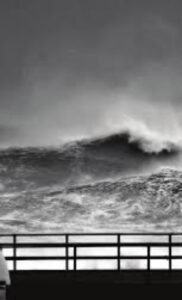 The normal hurricane season is from June 1 to November 30, and since we have our first hurricane in the Gulf of Mexico right now, it looks like it’s right on time. Nevertheless, for places like New York, where it is normally a little cooler, the hurricane season starts a little later, and may not really arrive at all. However, on June 4, 1825, a rare early hurricane arrived, moving off the East Coast and tracking south of New York. The hurricane caused several ship wrecks, and killed seven people.
The normal hurricane season is from June 1 to November 30, and since we have our first hurricane in the Gulf of Mexico right now, it looks like it’s right on time. Nevertheless, for places like New York, where it is normally a little cooler, the hurricane season starts a little later, and may not really arrive at all. However, on June 4, 1825, a rare early hurricane arrived, moving off the East Coast and tracking south of New York. The hurricane caused several ship wrecks, and killed seven people.
The National Hurricane Center, states that on average, hurricane winds have impacted the New York City area every 19 years, and major hurricanes, of a Category 3 or higher, only every 74 years. The highest hurricane reading, Category 5 hurricane is not expected to occur there at all, because of the climate conditions there.
Nevertheless, on June 4, 1825, forming ahead of what is now considered hurricane season, a severe tropical storm surprised the Atlantic seaboard from Florida to New York City. At that time, they did not have the prediction capabilities, and this storm was first sighted near Santo Domingo on May 28th. It moved across Cuba on June 1st, with gale force winds,  beginning at Saint Augustine, and approaching US soil on the June 2nd, and impacting Charleston, North Carolina on June 3rd.
beginning at Saint Augustine, and approaching US soil on the June 2nd, and impacting Charleston, North Carolina on June 3rd.
The tide in North Carolina rose six feet at New Bern and fourteen feet at Adams Creek. As the tide rushed in, more than 25 ships were driven ashore at Ocracoke, 27 near Washington, and also some at New Bern. The plantations on the coastal areas near the South River were inundated with water, causing a heavy loss of crops and livestock. New Bern experienced heavy damage near the waterfront.
The storm pummeled Norfolk, with horrific force for 27 hours as the storm passed by to the east beginning on the 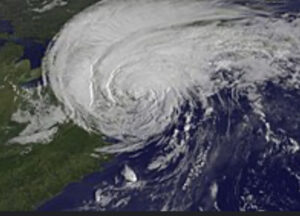 morning of June 3rd. The wind was relentless, uprooting trees as it went. At noon on June 4th, stores on the wharves were flooded in a surge up five feet deep. High winds howled through the Washington DC area. The storm then moved northeast past Nantucket on June 5th.
morning of June 3rd. The wind was relentless, uprooting trees as it went. At noon on June 4th, stores on the wharves were flooded in a surge up five feet deep. High winds howled through the Washington DC area. The storm then moved northeast past Nantucket on June 5th.
The storm reminded many people of the September gale of 1821, except that the September gale would have been much more common. There haven’t been many early June hurricanes in that area since 1825, but there have been a number of hurricanes to hit the area since, including Hurricane Sandy, which did much damage in New York City, including the subway area.
 In order to support a hurricane or typhoon, an area has to have one ingredient…warm ocean temperatures, generally above 82° F. The warm water sustains hurricanes and allows them to grow stronger. On the other hand, cooler sea surface temperatures will cause hurricanes to weaken, and in most cases, die out. The biggest difference between the East and West coasts of the United States are the sea surface temperatures. Because the Gulf Stream flows northwards along the East Coast, while sea surface temperatures along the West Coast are significantly cooler, the West Coast cannot usually sustain hurricanes. Of course, that doesn’t mean that it is impossible, as is shown in the 1962 Columbus Day Storm…also called the Big Blow and in Canada, Typhoon Freda.
In order to support a hurricane or typhoon, an area has to have one ingredient…warm ocean temperatures, generally above 82° F. The warm water sustains hurricanes and allows them to grow stronger. On the other hand, cooler sea surface temperatures will cause hurricanes to weaken, and in most cases, die out. The biggest difference between the East and West coasts of the United States are the sea surface temperatures. Because the Gulf Stream flows northwards along the East Coast, while sea surface temperatures along the West Coast are significantly cooler, the West Coast cannot usually sustain hurricanes. Of course, that doesn’t mean that it is impossible, as is shown in the 1962 Columbus Day Storm…also called the Big Blow and in Canada, Typhoon Freda.
The Columbus Day Storm was a Pacific Northwest windstorm that struck the West Coast of Canada and the Pacific Northwest coast of the United States on October 12, 1962. Starting out as a tropical disturbance over the Northwest Pacific on September 28th, the storm was the twenty-eighth tropical depression, the twenty-third tropical storm, and the eighteenth typhoon of the 1962 Pacific typhoon season. The system strengthened on October 3rd and became a tropical storm. At that time, it was given the name Freda, but later that day it became a typhoon as it moved northeastward. Before long the storm intensified, reaching its peak as a Category 3-equivalent typhoon on October 5th, with maximum 1-minute sustained winds of 115 mph and a minimum central pressure of 948 millibars. The storm maintained its intensity for another day, and then gradually weakened on October 6th. By October 9th, Freda had weakened into a tropical storm, and it looked 
 like the Pacific Northwest would dodge a bullet. Then Freda transitioned into an extratropical cyclone on October 10th. Freda turned eastward and accelerated across the North Pacific on October 11th, and finally made before striking the Pacific Northwest the next day. On October 13th, the cyclone made landfall on Washington and Vancouver Island, and then curved northwestward. After ripping through the west coast of the Washington and Canada, the system moved inland in Canada and weakened. By October 17th, it was absorbed by another developing storm to the south, and the event was over.
like the Pacific Northwest would dodge a bullet. Then Freda transitioned into an extratropical cyclone on October 10th. Freda turned eastward and accelerated across the North Pacific on October 11th, and finally made before striking the Pacific Northwest the next day. On October 13th, the cyclone made landfall on Washington and Vancouver Island, and then curved northwestward. After ripping through the west coast of the Washington and Canada, the system moved inland in Canada and weakened. By October 17th, it was absorbed by another developing storm to the south, and the event was over.
Nevertheless, the Columbus Day Storm of 1962 is considered to be the benchmark of extratropical windstorms to this day. As storm ranking goes, the Columbus Day Storm is listed as being among the most intense to strike the region since at least 1948, and quite likely since the January 9, 1880 “Great Gale” and snowstorm. With respect to wind velocity, the storm is also considered a contender for the title of the most powerful extratropical cyclone recorded in the United States in the 20th century. Even the March 1993 “Storm of the Century” and the “1991 Halloween Nor’easter” (“The Perfect Storm”) were no match. The system that drove the Columbus Day Storm brought strong winds to the Pacific Northwest and southwest Canada, was linked to 46 fatalities in the northwest and Northern California as a result of heavy rains and mudslides.

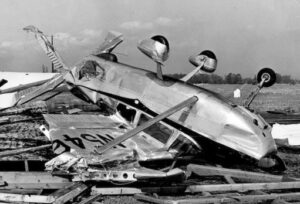
Normally, the storms that originate in the Pacific tend to weaken and die out as they reach the colder waters there. most don’t even recurve into the west coast after the leave the warmer gulf waters and head across Mexico. That is what made the Columbus Day storm so unusual for the area in which it took place.
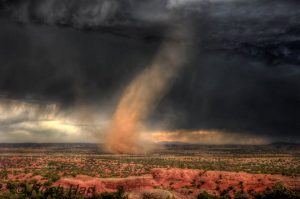 Weather has always been a subject of interest to people, even if we still don’t completely have a full grasp of it, not even after all these years and all our technology. The main difference I see now is that we hear about weather all the time. It’s on television, the radio, and even our phones. There are warnings for everything…thunder storms, tornadoes, snow storms, flash floods, and hurricanes. Nevertheless, all the meteorologists can truly do is predict a weather event. It may or may not materialize.
Weather has always been a subject of interest to people, even if we still don’t completely have a full grasp of it, not even after all these years and all our technology. The main difference I see now is that we hear about weather all the time. It’s on television, the radio, and even our phones. There are warnings for everything…thunder storms, tornadoes, snow storms, flash floods, and hurricanes. Nevertheless, all the meteorologists can truly do is predict a weather event. It may or may not materialize.
Now, flash back to, oh say 1680 or even to 1521. Other than looking at the sky, how did the people predict the weather? Yes the sky can be a great predictor of coming storms, but unless you knew something about weather  patterns, you would be unlikely to have any idea that something like a tornado, flood, or hurricane were coming. Especially in 1680 or 1521. Those dates are rather important in the world of weather. In August of 1521, a meteorological phenomenon occurred in the Basin of Mexico. There were no cameras back them, no cell phones or computers to record the event. The only known description appears in Book XII of the Florentine Codex, which is an account of the Spanish conquest of Mexico written in Nahuatl in the mid-sixteenth century. The account states that just before the fall of Mexico-Tenochtitlan a heavy storm which included a whirlwind struck the basin. The whirlwind hovered for a while above Tlatelolco, Tenochtitlan’s twin city. Then it moved to the lake where it disappeared.
patterns, you would be unlikely to have any idea that something like a tornado, flood, or hurricane were coming. Especially in 1680 or 1521. Those dates are rather important in the world of weather. In August of 1521, a meteorological phenomenon occurred in the Basin of Mexico. There were no cameras back them, no cell phones or computers to record the event. The only known description appears in Book XII of the Florentine Codex, which is an account of the Spanish conquest of Mexico written in Nahuatl in the mid-sixteenth century. The account states that just before the fall of Mexico-Tenochtitlan a heavy storm which included a whirlwind struck the basin. The whirlwind hovered for a while above Tlatelolco, Tenochtitlan’s twin city. Then it moved to the lake where it disappeared.
When the experts of today look at the account of the phenomenon in the context of the Nahua culture, and  comparing it with European descriptions of tornados and waterspouts, they can determine that the phenomenon was indeed a tornado. Their conclusion is further supported by eighteenth and nineteenth century pictorial and written evidence showing that tornadoes do occur in the territory now occupied by Mexico City. Since the tornado of Tlatelolco predates the Cambridge, Massachusetts, tornado of July 8, 1680, which had been thought to be the first recorded tornado in the Americas, the Tlatelolco tornado actually represents the earliest documented tornado in the Americas. Either way, since people didn’t really have much information to go on back then, I’m sure they first said some version of “What is that?!!?” At least, I know I would have.
comparing it with European descriptions of tornados and waterspouts, they can determine that the phenomenon was indeed a tornado. Their conclusion is further supported by eighteenth and nineteenth century pictorial and written evidence showing that tornadoes do occur in the territory now occupied by Mexico City. Since the tornado of Tlatelolco predates the Cambridge, Massachusetts, tornado of July 8, 1680, which had been thought to be the first recorded tornado in the Americas, the Tlatelolco tornado actually represents the earliest documented tornado in the Americas. Either way, since people didn’t really have much information to go on back then, I’m sure they first said some version of “What is that?!!?” At least, I know I would have.
 My niece, Jenny Spethman is a woman of many talents. She is first and foremost a woman of God, who loves the Lord with all her heart. Life has not always been a bed of roses for Jenny, but through it all, she and her husband, Steve made God their center, and He has given then the strength to weather the storms that life brings…and some of these were hurricanes or tornadoes. Most weren’t literally that type, but they did fly through the edge of a hurricane on their way to their honeymoon, so they learned to trust God very early on in their marriage. The loss of their daughter, Laila at 22 days old, is something that would have ripped many a marriage apart, but not Jenny and Steve. They pressed into the Lord, and learned to seek His comfort in all the sad days that followed her passing. God has carried them through…every storm.
My niece, Jenny Spethman is a woman of many talents. She is first and foremost a woman of God, who loves the Lord with all her heart. Life has not always been a bed of roses for Jenny, but through it all, she and her husband, Steve made God their center, and He has given then the strength to weather the storms that life brings…and some of these were hurricanes or tornadoes. Most weren’t literally that type, but they did fly through the edge of a hurricane on their way to their honeymoon, so they learned to trust God very early on in their marriage. The loss of their daughter, Laila at 22 days old, is something that would have ripped many a marriage apart, but not Jenny and Steve. They pressed into the Lord, and learned to seek His comfort in all the sad days that followed her passing. God has carried them through…every storm.

Jenny loves being a wife and mother. Her family is her everything. She attends the boys, Xander, Zack, and Isaac’s sporting events, and her daughter, Aleesia’s girly events, like dancing, cheerleading. With the boys in school all day, Jenny and Aleesia have had more time to spend doing girly time. The sad thing is that now, Aleesia is almost ready for full time school too, so Jenny is in the process of deciding who she will be then. I have been in that situation too, so I understand how that feels. When you are no longer a full time caregiver, as in my case, or a full time mommy, as in Jenny’s case, you start to think, “Ok, then who am I?” It’s a question every mom has to answers at some point.

The reality is that everyone has these moments when they need to basically re-invent themselves. Jenny is trying to decide now, if she will go back to school or go to work. I totally understand the vast array of feelings she has about this. She will miss being the stay-at-home mom, with all the kids around her, but there is a type of excitement that comes with a new adventure, be it work or study. All new adventures are often bittersweet…exciting on the one side, but sad too, because you are leaving the time of your children’s babyhood behind. Bittersweet as it may be, I know that Jenny will weather this storm just fine too. Today is Jenny’s birthday. Happy birthday Jenny!! Have a great day!! We love you!!
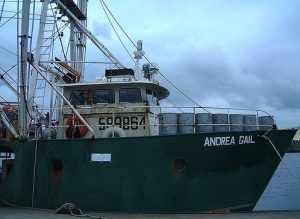
 After the movie, The Perfect Storm came out, swordfishing boat, Andrea Gail became almost a household name. We could relate to the feelings of loss the families of those men felt, and found it hard to get past the idea of how those men died. Those things are a normal reaction to such a tragedy, but in the end, we expected they would find the swordfishing boat, and be able to bring closure to the families…allowing them to bury their dead. Sometimes, however, a lost ship takes a long time to find, and strangely, sometimes it is never found at all. Such was the case with the Andrea Gail. Her last coordinates had been called out on the emergency radio, but this was such a fierce storm, and the Andrea Gail was right in the middle of it, trying desperately to make it back home.
After the movie, The Perfect Storm came out, swordfishing boat, Andrea Gail became almost a household name. We could relate to the feelings of loss the families of those men felt, and found it hard to get past the idea of how those men died. Those things are a normal reaction to such a tragedy, but in the end, we expected they would find the swordfishing boat, and be able to bring closure to the families…allowing them to bury their dead. Sometimes, however, a lost ship takes a long time to find, and strangely, sometimes it is never found at all. Such was the case with the Andrea Gail. Her last coordinates had been called out on the emergency radio, but this was such a fierce storm, and the Andrea Gail was right in the middle of it, trying desperately to make it back home.
The name Perfect Storm depicted not just another storm or even just another hurricane…this storm was a monster. The 1991 Perfect Storm, also known as the The No-Name Storm, especially in the years immediately after it took place, and the Halloween Gale, was a nor’easter that absorbed Hurricane Grace and ultimately evolved back into a small unnamed hurricane late in its life cycle. The area of low pressure developed off Atlantic Canada on October 29. A ridge of high pressure to its north pushed it southward. Then, it reached its peak intensity as a large and powerful cyclone. The storm battered the east coast of the United States with high waves and coastal flooding before it turned southwest and weakened. Moving over warmer waters, it transitioned into a subtropical cyclone before becoming a tropical storm. It made a loop off the Mid-Atlantic states and turned toward the northeast. On November 1 the system evolved into a full-fledged hurricane with peak winds of 75 miles per hour, although the National Hurricane Center left it unnamed to avoid confusion amid media interest in the predecessor extratropical storm. It later received the name “the Perfect Storm” after a conversation between Boston National Weather Service forecaster Robert Case and author Sebastian Junger. The system was the fourth hurricane and final tropical cyclone in the 1991 Atlantic hurricane season. The tropical system weakened, striking Nova Scotia as a tropical storm before dissipating. There were thirteen confirmed deaths from the storm, including six on board Andrea Gail.
Everyone who saw the movie, now also knows about the Flemish Cap, which is an area of the Atlantic Ocean off the coast of Nova Scotia, and was where the Andrea Gail was when The Perfect Storm began its rampage. The Andrea Gail had sailed from Gloucester, Massachusetts on September 20, 1991, and after a minimal catch, sailed for the Flemish Cap. After encountering high seas in the middle of the storm, the vessel made its last radio contact late on October 28 about 180 miles northeast of Sable Island. After that, they tried to make a run for it through the storm, rather than lose their catch to spoil. The Andrea Gail sank while returning to Gloucester. Over the next few days, only three pieces of debris were found, and the Coast Guard said those could have washed off the boat in rough seas. To date, the boat, and her crew, David Sullivan, Robert Shatford, William Tyne, Dale Murphy, Michael Moran, and Alfred Pierre, have never been found.
However…on December 2, 2011 the Daily Mail Reporter printed this story…Lobster pot tag washes up 3,000 miles away across the Atlantic…two decades after being lost in Perfect Storm that inspired film. “A tag from a lobster pot lost two decades ago in what came to be known as ‘The Perfect Storm’ has washed up 3,000 miles away in Ireland. The pot that held the tag with Richard Figueiredo’s name on it was one of hundreds he lost when the storm struck off Cohasset, Massachusetts, in 1991. Rosemary Hill, of Waterville, County Kerry, found the tag on a beach last year. Last week she decided to try to contact Mr Figueiredo and found him through the Facebook account of his son Rich. Oceanographer Curt Ebbesmeyer told The Patriot Ledger newspaper that the tag’s 20-year drift is unusually long. Mr Ebbesmeyer, who studies flotsam and ocean currents, said the pot and tag may have been buried in offshore mud before drifting south off the U.S. Atlantic coast and then getting caught the in eastward Gulf Stream. He added that the tag then probably drifted south again into the circular Subtropical Gyre current in the mid-Atlantic, making six three-year loops before it again caught the Gulf Stream toward Ireland. Coast to coast: The tag would have made several loops as it drifted with a leading oceanographer saying it may have clocked up 50,000 miles. He believes in total it could have drifted 50,000 miles. Miss Hill, 39, loves beachcombing and said that this is the first time she’s ever traced a buoy or other piece of maritime flotsam to its owner. She told The Patriot Ledger she saw the orange tag amid clumps of seaweed on a stroll last year. She added it to other beach souvenirs and then forgot about it until last week. ‘I 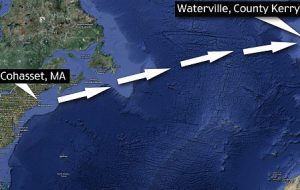
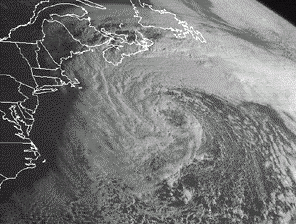 looked at it again and thought, “Why not try to find the owner?”‘ she said. ‘Nothing ventured, nothing gained.’ Mr Figueiredo and Miss Hill spoke last Thursday. She said she would mail the tag to him, but he wants her to keep it. He said: ‘The meaning it has over there is what matters. ‘I am honored that she has put so much enthusiasm into this. What’s happening now is a gift to me.'” I find that to be an absolutely amazing journey.
looked at it again and thought, “Why not try to find the owner?”‘ she said. ‘Nothing ventured, nothing gained.’ Mr Figueiredo and Miss Hill spoke last Thursday. She said she would mail the tag to him, but he wants her to keep it. He said: ‘The meaning it has over there is what matters. ‘I am honored that she has put so much enthusiasm into this. What’s happening now is a gift to me.'” I find that to be an absolutely amazing journey.
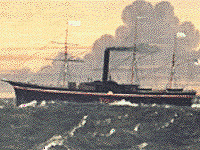 The San Francisco gold rush was a crazy time in American history. It was almost giddy in many ways. Gold does funny things to people. Just the thought of striking it rich made people pull up stakes and move west to try their hand at gold mining. Once people had made their fortunes, many decided to head back home to the east. Apparently the idea of wagon training back was not so appealing on the journey home, so these now, people of wealth decided to go by ship. The easiest crossing was through the Panama area. Of course, the Panama Canal was not built yet, although the French had tried to do so, but it wasn’t done yet. So the trip became a two ship journey.
The San Francisco gold rush was a crazy time in American history. It was almost giddy in many ways. Gold does funny things to people. Just the thought of striking it rich made people pull up stakes and move west to try their hand at gold mining. Once people had made their fortunes, many decided to head back home to the east. Apparently the idea of wagon training back was not so appealing on the journey home, so these now, people of wealth decided to go by ship. The easiest crossing was through the Panama area. Of course, the Panama Canal was not built yet, although the French had tried to do so, but it wasn’t done yet. So the trip became a two ship journey.
On August 20, 1857, several hundred passengers in San Francisco boarded the SS Sonora, of the Pacific Mail Steamship Line, and headed south toward Panama City. The 1857 value of the gold on board was 1.6 million, so just imagine today’s value. Thousands of freshly minted 1857-S double eagles, some earlier $20 coins, ingots, and gold in other forms were among the treasures. Some of the double eagles were stacked in long rows or columns and nestled in wooden boxes. Elsewhere around the ship, passengers had their own stash in purses and boxes reflecting their success in the land of gold. Once they arrived in Panama City, they were transported by train to on the Panama Railroad, which was a 48-mile line, completed in 1855 and had facilitated the crossing of the isthmus in about three or four hours as opposed to paddling and tramping through the jungles for several days. When the train arrived in Aspinwall, the passengers disembarked, and the treasure was transported to storage.
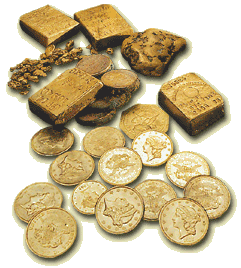 The next leg of the trip was aboard the side-wheel steamer SS Central America. The ship had been called the SS George Law, but the name was later changed to the SS Central America. It was now on its forty-fourth voyage for the Atlantic Mail Steamship Company. The Atlantic Mail Steamship Company was operating under federal mail contract to provide mail to the people between the east and west. The steamers had Navy captains at the helm, men of proven reputation and experience. Capt. William Herndon commanded the Central America.
The next leg of the trip was aboard the side-wheel steamer SS Central America. The ship had been called the SS George Law, but the name was later changed to the SS Central America. It was now on its forty-fourth voyage for the Atlantic Mail Steamship Company. The Atlantic Mail Steamship Company was operating under federal mail contract to provide mail to the people between the east and west. The steamers had Navy captains at the helm, men of proven reputation and experience. Capt. William Herndon commanded the Central America.
In early September 1857, the gold treasure was carefully packed aboard. The passengers found their cabins, and all were ready for the pleasant voyage to New York City. It was an ideal time of year for travel. A few days later, on September 7, 1857, the ship docked in the harbor of Havana. It was a popular stop for the passengers, who set about buying souvenirs and exploring the sights of the town. The trip toward New York continued to be pleasant. The skies were sunny and the sea smooth…temporarily.
At 5:30am on Wednesday, September 9, the ship’s second officer noted that the ship had gone 286 nautical miles in the preceding 26½ hours. He noted that a breeze was kicking up, and perhaps they were in for a storm, but expressed no concerns, because they were experienced and could handle a storm should it occur. That would prove to be the first mistake made. The storm grew furious and they were too far from a port to do much except keep the SS Central America into the waves. By Friday morning, September 11, the crew was still in control, but the ship was taking on water through the drive shaft, broken or open lights and elsewhere. The ship was tossing violently. It was virtually impossible to feed coal into the boilers.
At 11am Captain Herndon told the passengers that the ship was in grave danger. He enlisted the help of all men to bail water with a bucket brigade. By 1:00 in the afternoon the rising water in the hold doused the boiler 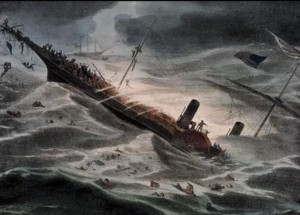 fires. The ship’s paddlewheels stopped. The SS Central America was at the mercy of the sea. By Saturday, the 12th of September, 1857, the storm started to pass, but it was too late. The SS Central America was doomed. The people were told to abandon ship, and the SS Central America went down with all of their treasure. In all, 425 lives were lost to the sea. Only 153 were pulled from a watery grave by the brig Marine, which was also damaged by the storm, though not to the degree of the SS Central America. The ship was discovered again on September 11, 1988, almost exactly 131 years after she went down in a hurricane on September 12, 1857. It was a rich find for Thomas G Thompson and his crew…and the museums who would reap much of the benefits.
fires. The ship’s paddlewheels stopped. The SS Central America was at the mercy of the sea. By Saturday, the 12th of September, 1857, the storm started to pass, but it was too late. The SS Central America was doomed. The people were told to abandon ship, and the SS Central America went down with all of their treasure. In all, 425 lives were lost to the sea. Only 153 were pulled from a watery grave by the brig Marine, which was also damaged by the storm, though not to the degree of the SS Central America. The ship was discovered again on September 11, 1988, almost exactly 131 years after she went down in a hurricane on September 12, 1857. It was a rich find for Thomas G Thompson and his crew…and the museums who would reap much of the benefits.

